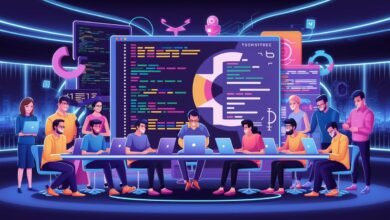The Future of PDF Reading: AI’s Revolutionary Impact

Introduction: The Evolution of PDF Reading
PDFs have long been the cornerstone of digital document sharing. Since their inception in the early 1990s, PDFs have provided a reliable, consistent format for documents across various platforms. Whether it’s academic papers, business reports, or e-books, PDFs ensure that the content remains unchanged no matter where it’s viewed. But as technology evolves, so does the way we interact with these documents.
Enter artificial intelligence. AI is not just poised to enhance how we read PDFs; it’s already reshaping our entire interaction with them. This blog post explores how AI is revolutionizing PDF reading, addressing traditional challenges, and predicting future advancements. Whether you’re a tech enthusiast, content creator, or educator, you’ll find valuable insights into the evolving world of PDF technology.
Traditional Challenges with PDFs
Reading PDFs has its fair share of challenges. For many years, users have struggled with issues like limited searchability, cumbersome navigation, and lack of interactivity. Let’s dive deeper into these pain points.
Searchability and Text Recognition
One of the primary difficulties with PDF documents is the searchability factor. Traditional PDF readers often fail to recognize text within scanned images or handwritten notes, making it hard to find specific information quickly. This limitation can be frustrating, especially when dealing with lengthy documents.
Navigation and User Experience
Navigating through a dense PDF can be a cumbersome process. Traditional readers offer minimal support for features like bookmarks, highlights, and annotations, which are essential for efficient document handling. Moreover, users often find themselves scrolling endlessly to locate relevant sections, wasting valuable time and energy.
Lack of Interactivity
PDFs are usually static, lacking the interactivity that modern users expect from digital documents. Whether it’s embedding videos, incorporating dynamic charts, or integrating hyperlinks, traditional PDF readers fall short in enhancing user engagement and interactivity.
AI to the Rescue: Enhancing PDF Reading Experiences
Artificial Intelligence is addressing the aforementioned issues head-on, transforming the PDF reading experience for both consumers and creators.
Advanced Text Recognition
AI-powered tools leverage Optical Character Recognition (OCR) to convert scanned images and handwritten notes into searchable text. Solutions like Adobe’s Liquid Mode and Google’s AI-driven document processing enable users to find information quickly and efficiently, regardless of the document’s original format.
Smart Navigation and Annotations
AI enhances navigation by automatically generating clickable tables of contents and dynamic bookmarks based on document structure. Additionally, AI-driven annotation tools allow users to highlight text, add comments, and even extract key information with just a few clicks. These features make it easier to manage and interact with PDFs, significantly improving user experience.
Interactive Elements
With AI, PDFs are no longer static documents. Modern AI tools can embed multimedia elements, such as videos and interactive charts, directly into PDFs. This not only makes the documents more engaging but also provides a richer, more immersive reading experience.
Real-World Applications of AI in PDF Reading
The impact of AI in PDF reading isn’t just theoretical; it’s already transforming various fields, from education to business, and enhancing workflows and information accessibility.
Education
In academic settings, AI-powered PDF readers are enabling educators and students to interact with course materials in new ways. Features like automated summarization, enhanced search functions, and interactive annotations help streamline the learning process. Students can now easily find and highlight key concepts, while educators can annotate and share feedback more efficiently.
Business
In the corporate world, AI is revolutionizing how businesses handle documents. AI-driven tools can automate data extraction from PDFs, reducing manual data entry and minimizing errors. Additionally, enhanced search capabilities and smart categorization make it easier for employees to locate and utilize critical information, boosting productivity.
Content Creation
Content creators are benefiting immensely from AI advancements in PDF technology. Enhanced text recognition and annotation tools simplify the editing process, while AI-driven layout and design suggestions help create more visually appealing documents. These innovations save creators time and effort, allowing them to focus on producing high-quality content.
Predictions for the Future of PDF Reading with AI
The future of AI in PDF reading holds immense potential. As AI technology continues to evolve, we can expect even more groundbreaking developments in this space.
Personalized Reading Experiences
AI could soon offer personalized reading experiences by analyzing user preferences and behavior. Imagine a PDF reader that adjusts the layout, font size, and color scheme based on your reading habits, providing a tailored experience that enhances comprehension and comfort.
Voice-Activated Features
Voice-activated PDF readers are another exciting possibility. AI-driven voice assistants could help users navigate documents, search for specific information, and even read the text aloud. This would be particularly beneficial for individuals with visual impairments or those who prefer auditory learning.
Enhanced Collaboration
Future AI-powered PDF readers could include advanced collaboration features, allowing multiple users to annotate, comment, and edit documents in real time. This would facilitate seamless teamwork and improve productivity, especially in remote work environments.
Tips for Integrating AI-Powered PDF Reading into Your Routine
Adopting AI-powered PDF readers can significantly enhance your workflow and productivity. Here are some tips for integrating these tools into your daily routine.
Choose the Right Tool
Select an AI-powered PDF reader that best fits your needs. Consider features like text recognition, smart navigation, and interactive elements when making your choice. Popular options include Adobe Acrobat DC, Foxit PhantomPDF, and Google Drive’s OCR capabilities.
Leverage Annotation Features
Take full advantage of AI-driven annotation tools to highlight important information, add comments, and create bookmarks. This will help you stay organized and make it easier to reference key points later.
Automate Data Extraction
Use AI-powered tools to automate data extraction from PDFs. This will save you time and reduce the risk of errors, allowing you to focus on more strategic tasks.
Conclusion: Embracing the AI Revolution in PDF Reading
Artificial Intelligence is undoubtedly transforming the way we read and interact with PDFs. From enhancing searchability and navigation to adding interactivity and improving workflows, AI-powered tools are revolutionizing the PDF reading experience.
For tech enthusiasts, content creators, and educators alike, embracing AI in PDF reading means staying ahead of the curve and unlocking new possibilities for productivity and engagement. So, take the plunge and explore the world of AI-powered PDF readers. The future of document interaction is here, and it’s more exciting than ever.
Are you ready to revolutionize your PDF reading experience? Start exploring AI-powered tools today and discover the endless possibilities they offer!


